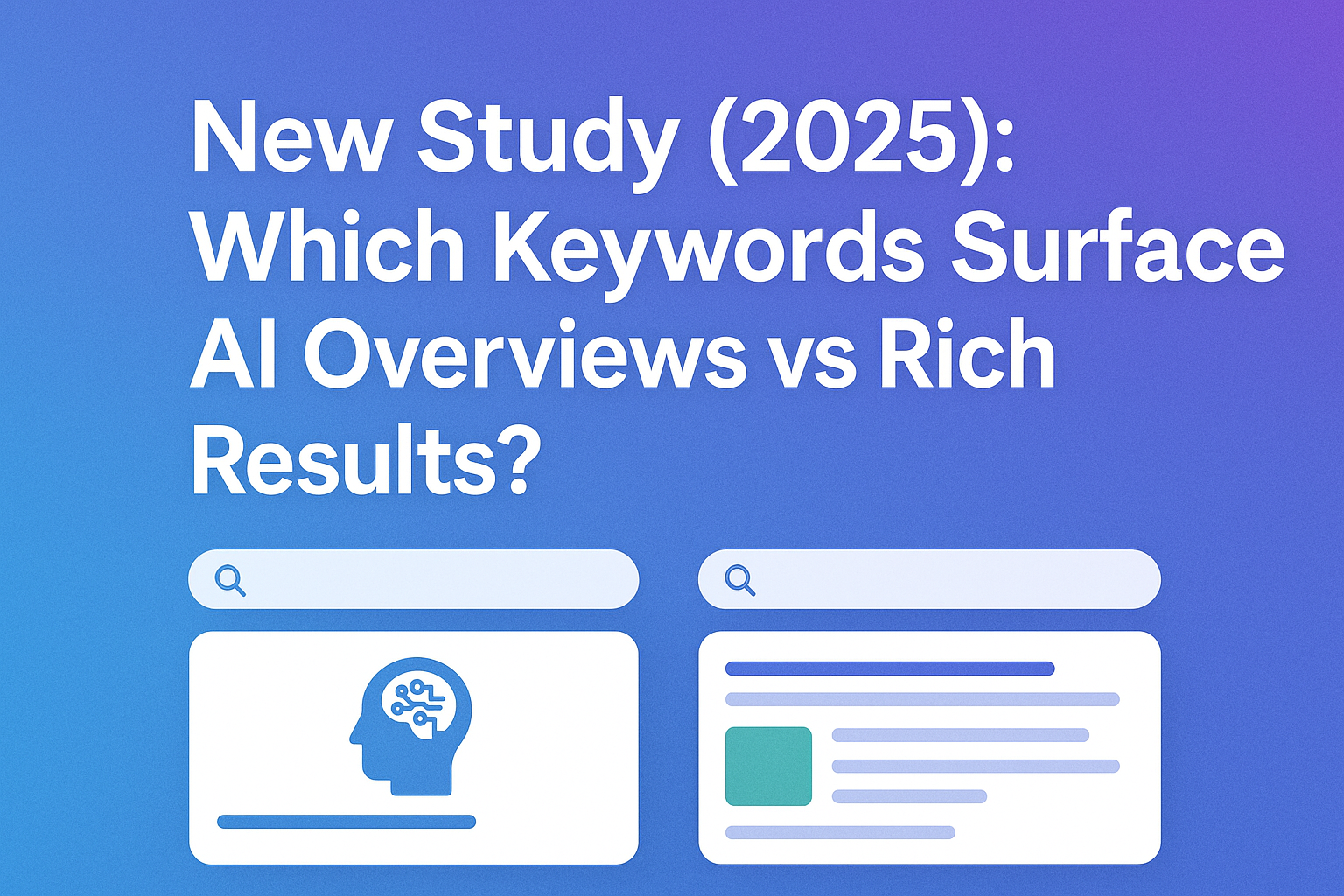Our new 2025 study of 2,000 keywords reveals when Google shows AI Overviews vs rich results. See which queries trigger visibility and why it matters.
TL;DR
- AI Overviews dominate informational queries, appearing in 77% of “how/what/why” searches.
- Commercial queries are split: 49% trigger AI Overview, making visibility here unpredictable but high-stakes.
- Transactional queries rarely show AI Overview (29%), with product schema still leading.
- Navigational queries are a wildcard: half trigger AI Overview, sometimes boosting, sometimes diluting brand control.
- Video is the strongest rich result, surfacing in 80% of informational and 58% of commercial queries.
- AI Overview and Video snippet co-occur 59% of the time, confirming Google’s push toward blended summary + visual results.
Search has changed. Blue links are no longer the default entry point.
AI Overviews now dominate the top of Google results, pulling together answers that buyers often read before clicking. For brands, this shift raises a critical question: when do AI Overviews appear, and which keywords still surface traditional rich results?
To find out, the team at LangSync AI, an AEO agency, analysed 2,000 keywords across four intents: informational, commercial, transactional, and navigational. Each keyword was tested for AI Overviews and the main rich result formats: video, paragraph, list, image, and table.
The results reveal the new rules of visibility in AI-driven search.
Here’s a quick summary of our findings.
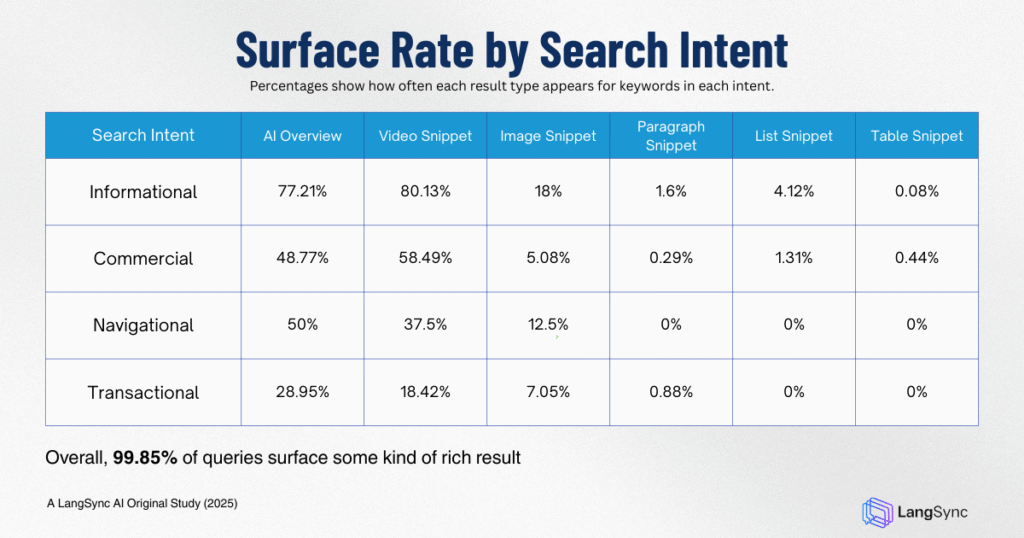
Table of Contents
Why this study matters
Search behaviour has always been shaped by how results are displayed.
The difference today is that AI Overviews rewrite the order of importance. Instead of scanning ten blue links, buyers can consume an instant summary before they even scroll.
- Decision-making happens inside AI Overviews: If your brand isn’t represented there, you are invisible at the very moment intent is strongest.
- Traditional snippets still exist, but they are pushed down: Brands that once relied on paragraph or list snippets are finding that AI is taking their spot.
- The rules are shifting fast: Understanding which queries surface Google AI Overview versus which still rely on rich results is the foundation of any modern search strategy.
In short: Knowing the surfaces means knowing where to fight for visibility.
Methodology
Dataset
We worked with a dataset of 2,000 unique, randomly selected keywords, each mapped to a specific search intent and annotated with the presence or absence of result surfaces.
Search intent taxonomy
- Informational: Keywords that seek understanding. E.g “how to fix…”, “what is…”, “why does…”
- Commercial: Research and comparison before purchase. E.g. “best CRM software”, “laptop reviews”
- Transactional: Ready-to-act searches. E.g. “buy iPhone 15 online”, “cheap flights to Madrid”
- Navigational: Bbrand- or site-specific searches. E.g. “BBC weather”, “Nike store London”
Surfaces tracked
For each keyword, we tested for the presence of:
- AI Overview
- Paragraph Snippet
- List Snippet
- Video Snippet
- Image Snippet
- Table Snippet
- Rich Results (any type)
Coding and cleaning
- Intents were standardised to four canonical categories, correcting common misspellings.
- Yes/No flags were normalised into true/false values.
Metrics
- Surface rate by intent: the percentage of keywords in each intent that surfaced a given result type.
- Co-occurrence: the percentage of times two surfaces appeared together.
Limitations
Search results are fluid. SERPs vary by time, device, location, and user context. The study captures a snapshot of 2,000 queries, not a complete picture of the web. Trends are directional, not absolute.
AI Overview key findings
1. AI Overviews love informational queries
Our study revealed that 77% of informational queries surfaced an AI Overview.
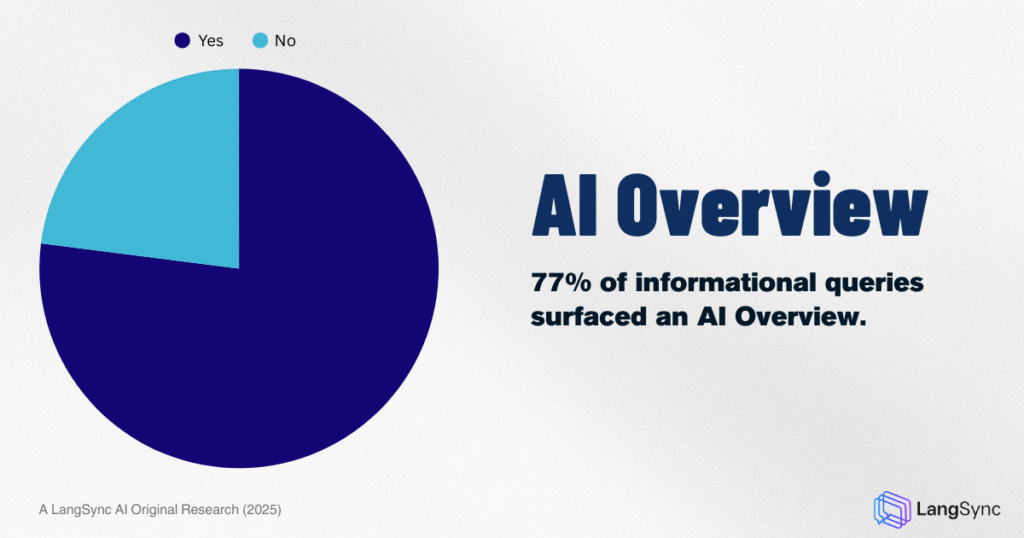
This shows a clear preference from Google to handle “how”, “what”, and “why” questions with AI-generated summaries rather than relying on classic snippets. These queries typically represent the earliest stage of the customer journey, when people are still seeking knowledge and forming opinions.
Instead of directing users to individual articles, Google increasingly surfaces a consolidated AI response that blends multiple sources into a single, authoritative-looking answer.
Why It Matters
Informational queries are where brand discovery happens.
If your business publishes explainer guides, educational blogs, or thought-leadership pieces, these are exactly the queries that introduce you to potential customers.
With AI Overview dominating this space, brands that fail to appear in these summaries risk losing visibility at the very start of the buyer journey. In other words, you miss the chance to build trust before a competitor even enters the picture.
Tips for Businesses
- Optimise for AI extraction: Write concise, structured answers to common “how/what/why” queries.
- Embed authority signals: Use citations, expert quotes, and schema markup to increase trustworthiness.
- Add multimedia: Pair guides with video demonstrations, as AI Overview and Video Snippets often co-occur.
- Cover the basics: Ensure content is clear, factually accurate, and easy to parse for AI systems.
Key Takeaway: If you want to win top-of-funnel visibility in 2025, informational AI Overviews are the new battleground.
2. Commercial queries are split
Our analysis reveals that 49% of commercial queries triggered an AI Overview.
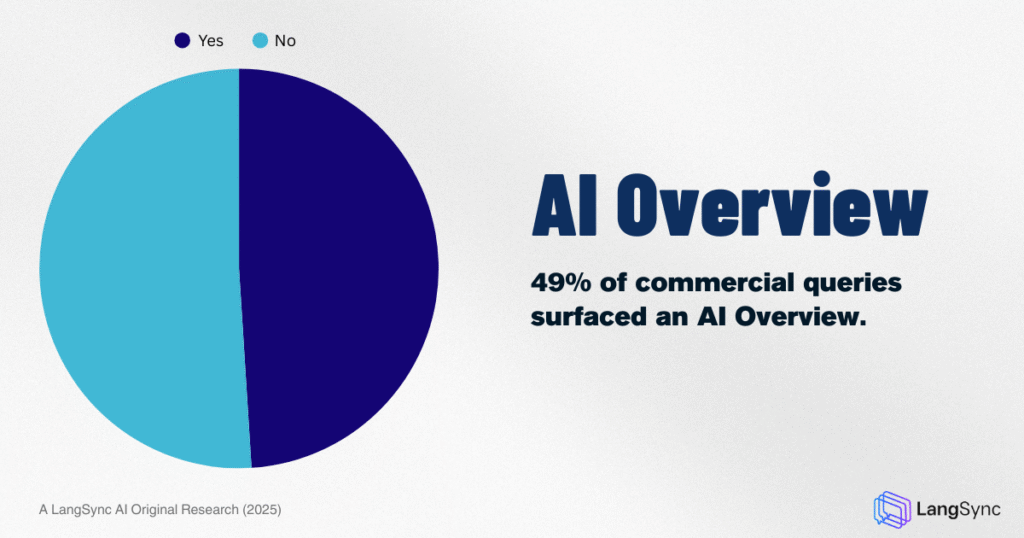
This “coin-flip” outcome makes commercial intent the most unpredictable category in our study.
Commercial queries; terms like “best CRM software”, “top laptops 2025”, or “cheapest insurance providers” sit squarely in the consideration stage of the funnel. Here, buyers weigh options, compare features, and seek validation before committing to a purchase.
What makes this space unique is that AI Overview doesn’t always dominate.
For half of these queries, Google still falls back on more traditional surfaces like review snippets, product carousels, or video roundups. This uncertainty forces brands to compete on two fronts simultaneously: AI-driven Overviews and legacy-rich results.
Why It Matters
This is the stage where revenue is won or lost.
If a competitor’s product or brand is highlighted in an AI Overview and yours is absent, the buyer may never reach your website. Conversely, a strong AI Overview presence can position your brand as a trusted solution before the buyer clicks further.
In competitive categories like SaaS, finance, and ecommerce, AI Overview visibility can directly influence funnel performance.
Tips for Businesses
- Optimise for comparisons: Build dedicated “X vs Y” and “best of” pages that AI can summarise.
- Leverage structured data: Use product, review, and FAQ schema to strengthen Google AI Overview eligibility.
- Highlight differentiators clearly: Short, bulleted product benefits are easier for AI to extract.
- Support with visuals: Incorporate product images and explainer videos to boost multi-surface coverage.
Key Takeaway: In commercial searches, appearing in the AI Overview can be the difference between being shortlisted or being forgotten.
3. Transactional intent lags behind
Only 29% of transactional queries surfaced an AI Overview, making this intent the least likely to surface AI-generated answers.
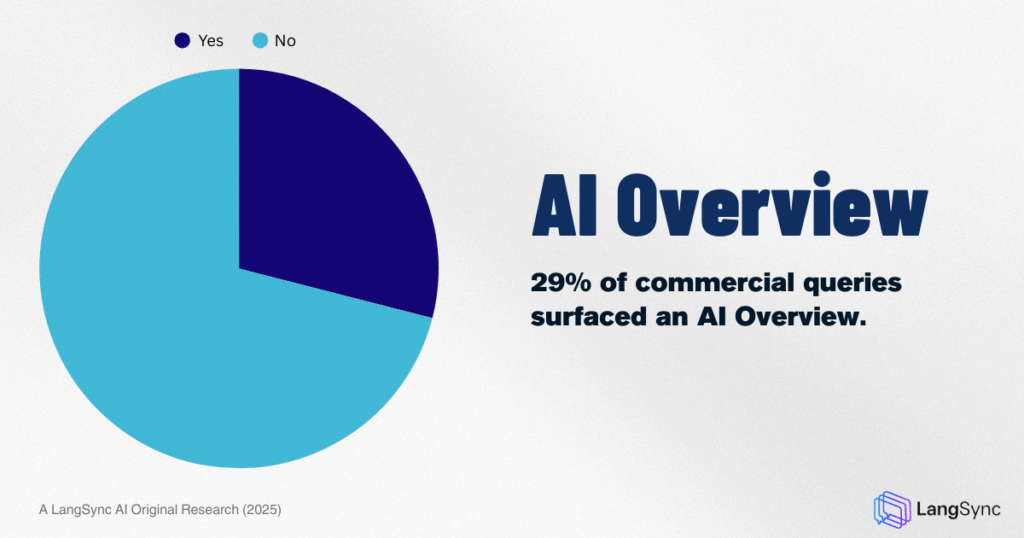
Transactional queries; phrases like “buy iPhone 15 online”, “book flight to Madrid”, or “order pizza near me” sit at the bottom of the funnel, where users have high purchase intent and are ready to act.
In these situations, Google continues to rely heavily on structured product results, such as shopping feeds, review stars, sitelinks, and price listings.
This suggests that for transactions, clarity and accuracy of product data still outweigh the utility of a summarised AI response. Google is prioritising commerce-specific SERP features designed to drive direct action rather than exploratory summaries.
Why It Matters
For businesses, this means Google AI Overview is not the primary battleground for bottom-of-funnel conversions.
Instead, structured data and feed optimisation remain critical. If your product information, availability, and pricing are well marked up, you stand a much better chance of surfacing in shopping carousels, product panels, or other transactional results.
In short, visibility here is less about being the “answer” and more about being the “option to click and buy.”
Tips for Businesses
- Invest in schema: Prioritise product, offer, and review schema to maximise eligibility for product snippets.
- Keep feeds accurate: Ensure Google Merchant Centre and ecommerce feeds are clean, up to date, and match on-site details.
- Show price and availability: Displaying accurate, real-time pricing improves visibility and click-through.
- Optimise meta titles and descriptions: Even small tweaks can help win clicks when Google AI Overview isn’t present.
Key Takeaway: For high-intent queries, winning the transaction still depends on structured product data, not AI Overviews.
4. Navigational is a wildcard
Our study found that 50% of navigational queries surfaced an AI Overview, a surprisingly high figure.
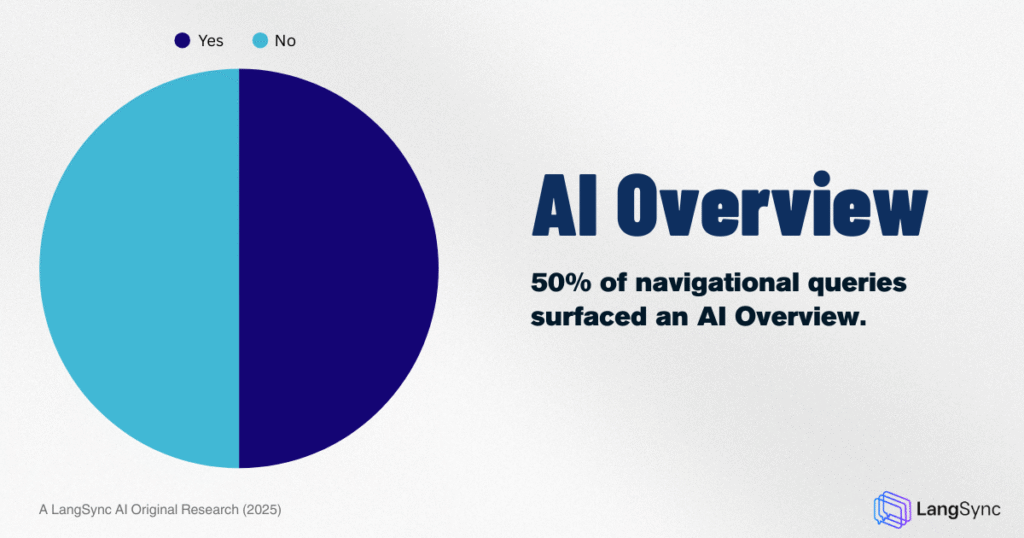
Navigational queries are typically brand- or site-specific, like “Nike store London”, “BBC weather”, or “Langsync blog”. Traditionally, these searches were the most predictable: a clear brand site, map listing, or official resource would dominate the results.
The fact that half of these queries now surface an AI Overview shows how unpredictable this category has become. Instead of serving a straightforward link, Google often provides additional context, competitor mentions, or explanatory notes.
For example, a navigational search might pull in background information about a brand, its products, or even alternative options. This makes navigational intent the wildcard of Google AI Overview surfaces; sometimes reinforcing brand presence, other times diluting it.
Why It Matters
For brands, this shift represents both a risk and an opportunity.
The risk is loss of brand control: even when a user is clearly looking for you, Google may frame the result in a broader context that mentions rivals. The opportunity lies in brand positioning: if your competitors are surfacing Google AI Overview on navigational searches for your category, your absence could make you look less relevant. Conversely, if you appear in Google AI Overviews for competitor navigational queries, you may intercept warm traffic.
Tips for Businesses
- Monitor your own brand queries: Track when Google AI Overview appears for your name and what context it shows.
- Defend your space: Ensure your “About” pages, knowledge panels, and FAQs are optimised to influence Google AI Overview content.
- Track competitors: Identify when your rivals’ brand queries surface in Google AI Overview and see if you can position content to appear.
- Optimise Wikipedia and third-party profiles: These often get pulled into Google AI Overview for context.
Key Takeaway: Navigational queries are no longer guaranteed safe ground. AI Overviews can both strengthen and dilute brand presence in equal measure.
Rich results: what still matters?
While AI Overviews dominate, traditional rich results haven’t disappeared. Instead, they play a more complementary role, shaping how information is presented visually or interactively.
Here’s how each format is performing today:
Video Snippets
Video Snippets are by far the most frequent rich result format, appearing in 80% of informational queries and 58% of commercial queries in our study.
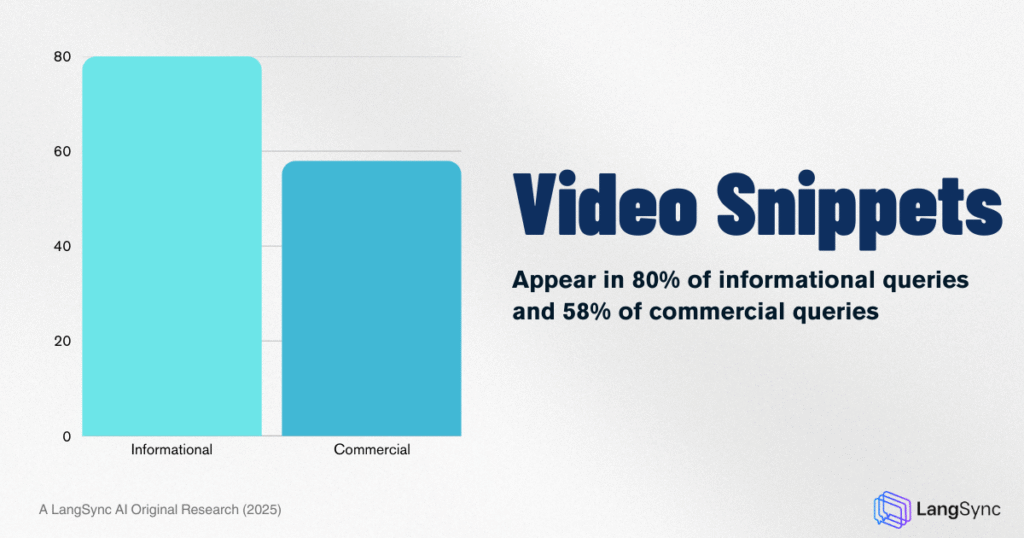
This is a striking indicator that Google is prioritising visual, demonstrative content alongside AI-generated summaries.
For users, video is often the fastest way to understand a process or evaluate a product. Whether it’s a tutorial, unboxing, or review, a video delivers a kind of clarity that text alone cannot.
For brands, this means that having optimised, high-quality video content is no longer optional. It’s a core visibility strategy. YouTube in particular remains a powerful feeder into these results.
Image Snippets
While less dominant than video, Image Snippets still appear in 18% of informational queries.
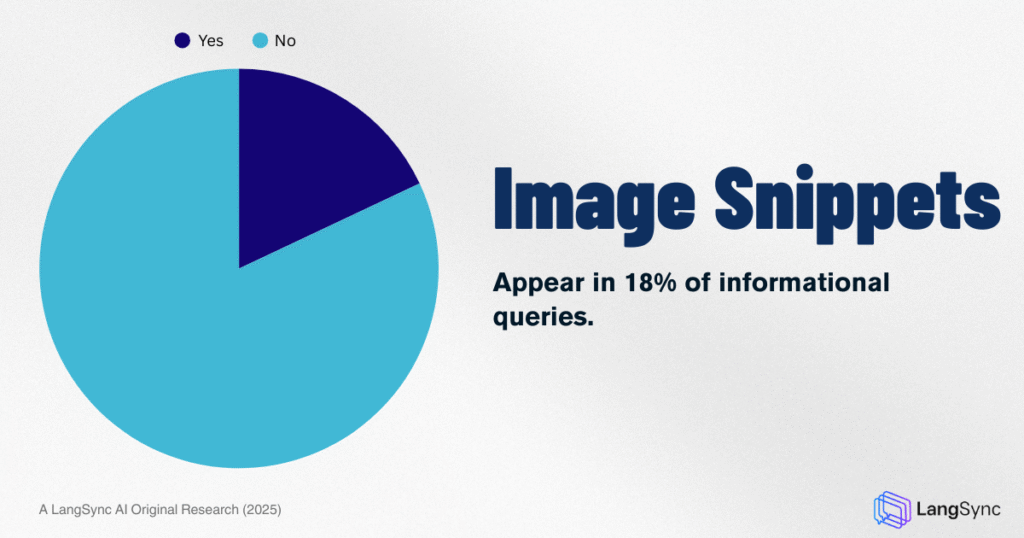
They serve as quick visual cues that help users validate what they’re looking for. For example, an image carousel might display different product models, design variations, or step-by-step illustrations.
The relatively modest percentage highlights that images aren’t as central to Google’s current SERP strategy as video, but they remain a useful supplement. Brands that provide clean, well-optimised imagery (with alt text, captions, and product schema) can increase their chances of surfacing here.
Paragraph & List Snippets
Paragraph and List Snippets were once the crown jewel of search visibility, but today they are nearly extinct in the dataset, appearing in fewer than 5% of queries combined (informational, commercial, transactional and navigational).
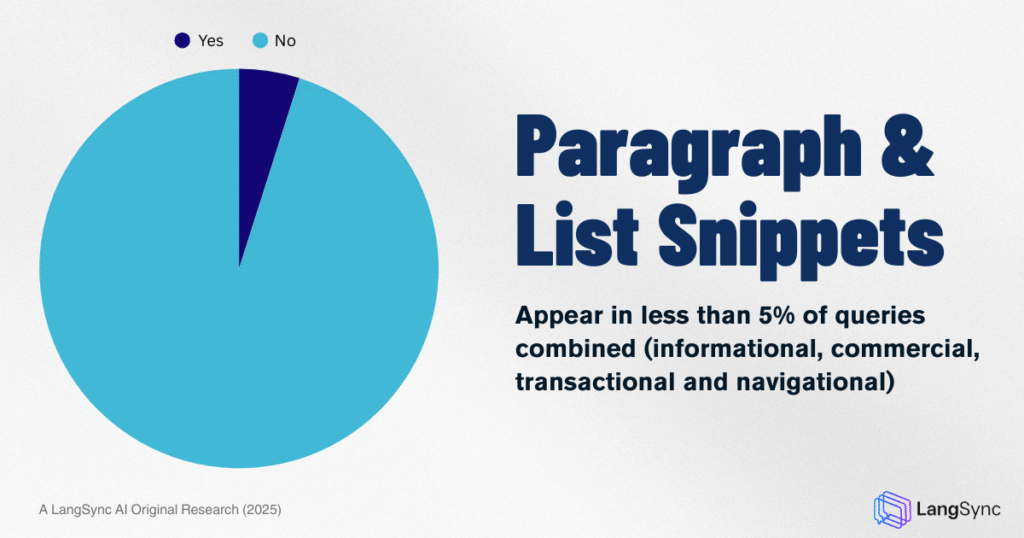
This reflects the impact of AI Overviews, which now consolidate and reframe the content that once would have been pulled into these snippets. Where a clear step-by-step list or short explanatory paragraph might previously have won the “position zero” spot, Google now prefers to summarise multiple sources with AI.
For brands, this means that legacy snippet optimisation is no longer enough.
If you’ve been focusing heavily on paragraph or list snippets, it’s time to adjust. AI Overview now plays the role it once filled.
Table Snippets
Table Snippets are statistically irrelevant in today’s SERPs, appearing in only 0.2% of queries in our study.
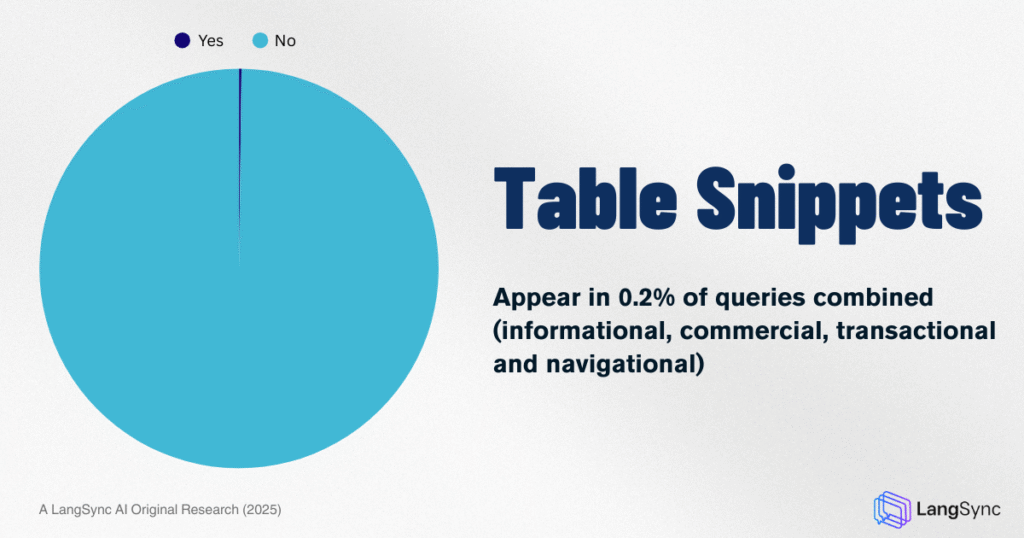
Once useful for showing structured data such as price comparisons or schedules, they have largely been absorbed into AI-generated summaries or interactive modules.
This suggests that Google no longer sees value in presenting static tables as standalone answers. Instead, it folds structured data into richer, more dynamic surfaces.
Co-occurrence patterns
Some surfaces are more likely to appear together, signalling how Google curates the SERP experience.
These overlaps reveal the design logic behind modern results pages: AI doesn’t work in isolation; it layers multiple result types to deliver a mix of summary, context, and demonstration.
AI Overview + Video
AI Overviews and Video Snippets appeared together in 59% of cases.
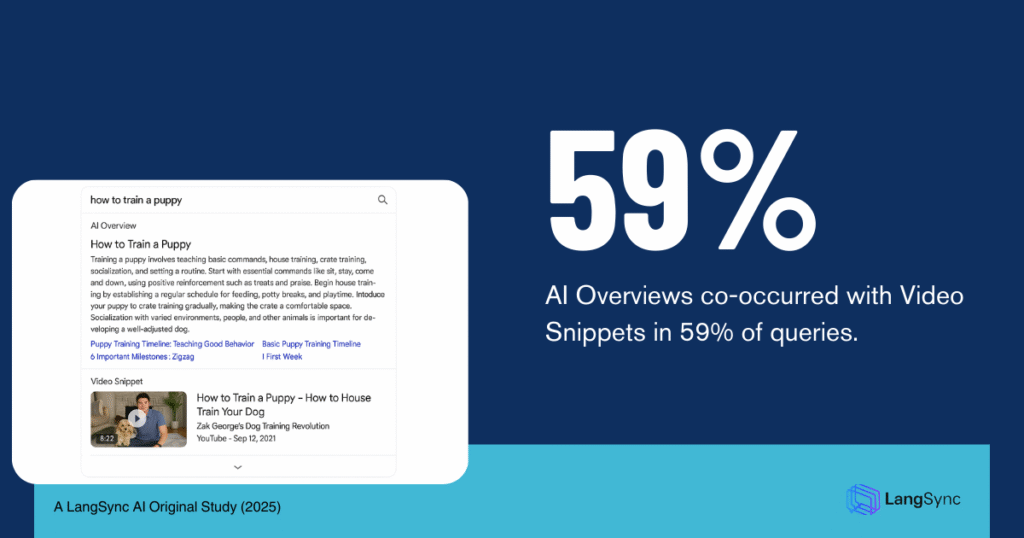
This is by far the strongest pairing we observed. It highlights Google’s preference for blending summarised text with practical, visual walkthroughs. A user might see an AI Overview that explains the steps of a process, alongside a video that demonstrates those steps in real time.
For brands, this means written content alone is not enough. If you want to dominate these blended SERPs, pair clear textual answers with polished video tutorials, product demos, or explainer clips.
AI Overview + Image
Images co-occurred with AI Overviews in 13% of queries.
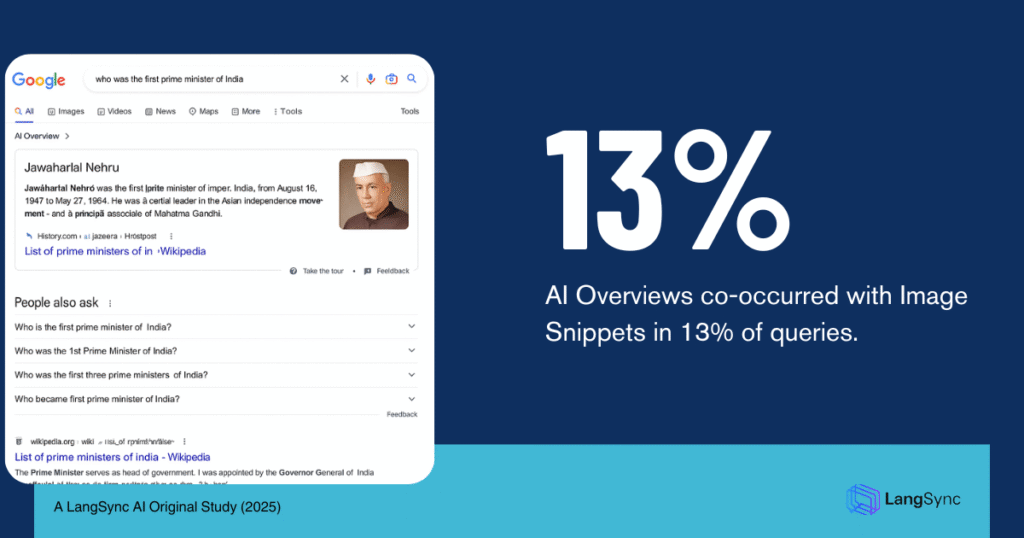
While not as dominant as video, this pairing still matters because images serve as instant visual validation. For example, if the Google AI Overview describes a product, the image carousel reinforces trust by showing the actual item.
For businesses, investing in high-quality product images, infographics, and descriptive alt text can help you surface in this supportive role.
AI Overview + Paragraph/List
Traditional snippets (paragraphs and lists) rarely co-occurred with AI Overviews, appearing together in only 1–2% of queries.
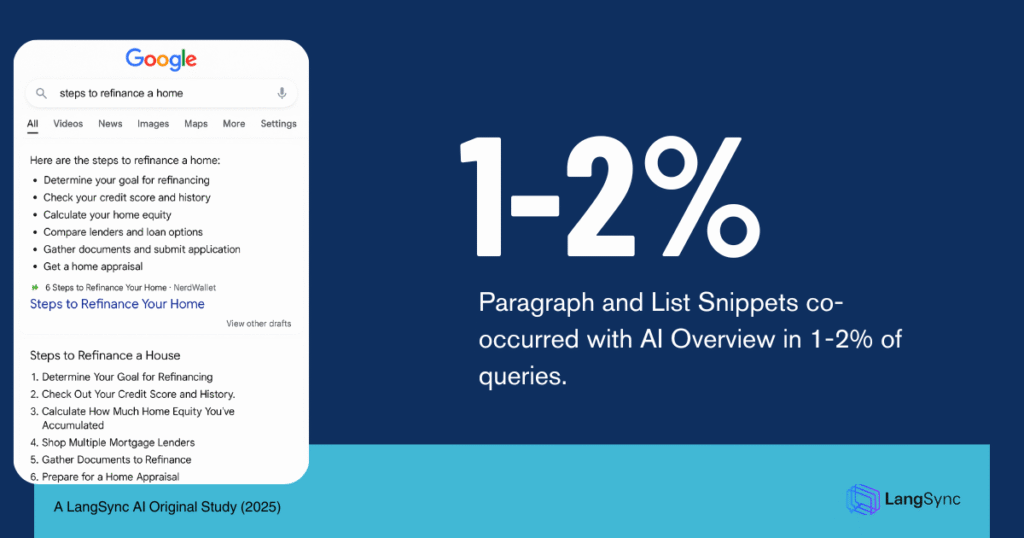
This finding underscores how AI has effectively replaced the role these snippets used to play. Instead of pulling a single paragraph or list from one page, Google now prefers to consolidate multiple sources into an AI Overview.
This reinforces the need to optimise content for AI extraction, not just for legacy snippets. Lists and paragraphs should still exist in your content — but more as inputs for Google AI Overview rather than as standalone ranking plays.
The bigger picture
These co-occurrence patterns suggest that AI Overviews are rarely presented in isolation. Google’s design strategy is to combine a narrative answer with either a visual (video or image) or supporting elements. The goal is to satisfy both quick readers and visual learners without requiring a click.
What these findings mean for brands
If your keywords are informational
- Prioritise AI Overview optimisation.
- Write short, authoritative answers designed for extraction.
- Embed video wherever possible. AI Overview and video are practically inseparable.
If your keywords are commercial
- Treat Google AI Overview as a product-research arena.
- Build comparison pages, utilise structured markup, and implement a review schema.
- Support with images to improve the odds of surfacing in carousels.
If your keywords are transactional
- An AI Overview is rare.
- Continue focusing on product schema, price feeds, and strong metadata to win the click.
Key Takeaways
- Audit your keywords by intent: AI Overviews behaviour varies dramatically from 77% in informational to just 29% in transactional.
- Don’t ignore video: It is the single richest co-signal for AI Overview.
- Legacy snippets are fading: Paragraphs and lists now play a marginal role.
- AI Overviews are the new front page of Google: Visibility here is the difference between being seen and being invisible.
AI Overview Vs Rich Results: Closing Thought
Optimising for AI Overviews is no longer optional. They represent the new reality of search. For brands, the choice is stark: be the answer, or be invisible.
To request the full dataset or book an AI Visibility Audit, get in touch with LangSync AI.
